
How Does an El Niño Start and Stop?
THE ENSO PHASES, EL NINO AND LA NINA, have profound impacts throughout the Pacific basin and neighboring continents. What begins as a local adjustment in sea level and depth of the thermocline in the western Pacific can spread across the equatorial Pacific, triggering an El Nino. Once established, an El Nino directly impacts weather in […]

What Are the Phases of ENSO?
THE ATMOSPHERE OCEAN SYSTEM in the equatorial Pacific is constantly changing. Although each year has its own unique characteristics, certain atmosphere-ocean patterns repeat, displaying a limited number of modes. We can use surface-water temperatures in the eastern equatorial Pacific to designate conditions as one of three phases of the El Nino-Southern Oscillation (ENSO) system — […]
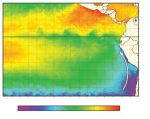
What Are El Niño and the Southern Oscillation?
THE MOST WELL KNOWN AND PUBLICIZED cause of climate variability, floods, droughts, hurricanes, heatwaves, and landslides is a change in the strength of winds and ocean currents west of South America in what has become known as El Nino. El Nino is one expression of the ocean-atmosphere system operating over and within the equatorial Pacific […]

What Is the Global Pattern of Surface Currents?
CONCEPTUAL MODELS OF REALITY, like the pole-to-pole ocean on the previous page, help us to draw general conclusions about the operation of physical processes. They also serve to highlight locations, or physical conditions under which the simplified overriding ideas prove inadequate in explaining observed phenomena. The global figure below depicts a summary of major surface […]
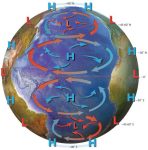
What Causes Ocean Currents?
SURFACE WATER OF THE OCEANS circulates in huge currents that generally carry warmer water toward the poles and colder water toward the equator. Extremely large quantities of energy are stored in the uppermost 100 meters of the global oceans, and surface ocean currents redistribute this energy from one part of the ocean to another, carrying […]
El Nino Wreaks Havoc
The complex, interrelated geology of the Andes, the Atacama Desert, and the Atacama Trench all come together in the face of El Nino, a weather pattern that affects the whole planet. The microscopic plankton that grow in the sunlit waters of the upper ocean provide the foundation for the ocean's food chain, just as grass […]

El Nino and La Nina
Moody, tempestuous, violent: it's so easy to assign human qualities to El Nino and its companion, La Nina. This pair of atmospheric cycles broke into the news in the late 1990s when a remarkably strong El Nina wreaked global havoc. The pithy name fits well with headlines, and the concept – a strange, portentous warming […]
The people who know El Nino best
In Spanish, El Nino means 'the male infant” or, when capitalized, the Christ child. Peruvians began applying the term to the ocean and atmosphere more than a century ago. Navy captain Camilo Carrillo noted in 1892 that local sailors referred to a periodic warming of the Pacific, which often occurred around Christmas, as El Nino. […]

Nino or Nina?
El Nino has hit the headlines as a codeword for bad weather, especially in the Pacific and California. But there is a little more to it than that. The name El Nino might suggest a relatively benign phenomenon. Would the devout Catholics of Latin America call something after the Baby Jesus if it was particularly […]

Current affairs
Like the rocks beneath and the vapours above, the waters of the Earth see no reason to stay still. And if you recall the heat engine that drives the atmosphere from the previous chapter, you will soon see the analogies with ocean systems. As with the atmosphere, the best place to start describing the way […]
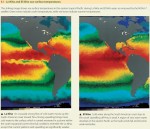
El Nino
At irregular intervals of about three to eight years, a remarkable disturbance of ocean and atmosphere occurs in the equatorial Pacific region—El Nino. Its name comes from Peruvian fishermen, who refer to the Corriente del Nino or the “Current of the Christ Child,” to describe an invasion of warm surface water once every few years around Christmas time that greatly depletes their […]
Current Research Issues
Over the past 20 years, we have witnessed an exponential growth of border studies, predominantly in Europe and North America. The enlargement of the EU in 2005 brought about a change in the meaning and permeability of the Union's internal and external borders, while 9/11 resulted in putting the meaning of the outer borders of the US into a new geopolitical […]
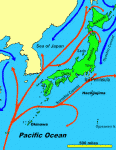
Kuroshio Current
THE KUROSHIO IS a warm northeasterly ocean current off the coast of JAPAN. This current is also called the gulf stream of the Pacific or Japan Current. Kuroshio means “the black stream” in Japanese, named after the deep ultramarine color of the high salinity water, which is found flowing north of the current's axis. The […]

Humboldt Current
THE HUMBOLDT CURRENT, also known as the Peru Current, is an ocean current that flows along the western coast of South America, affecting the water and air temperatures of coastal CHILE and PERU. It is one of the largest ocean currents in the world, bringing cold water north from the South PACIFIC for thousands of […]
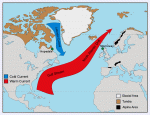
Gulf Stream
THE GULF STREAM, a relative newcomer on the geological scene, is an odd, fast-moving circulation of warm water that travels in an unfixed position, a few hundred miles north of FLORIDA, up the east coast of the UNITED STATES to Cape Hatteras, NORTH CAROLINA, then onto Nantucket Island, before kicking eastward across the ATLANTIC OCEAN […]
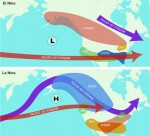
El Nino and La Nina
EL NINO AND La Nina are parts of global weather systems that recur every two to seven years. An El Nino, which usually lasts 12 to 18 months, is characterized by warm winters and wet springs in North America, a lessening of monsoonal rains in Asia, and droughts affecting Africa and the south PACIFIC OCEAN. […]
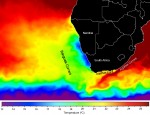
Benguela Current
THE BENGUELA CURRENT is one of the world's four major eastern boundary currents. It flows northward off the coast of southwestern Africa along the western coasts of SOUTH AFRICA, NAMIBIA, and southern ANGOLA. The Benguela Current, along with the South Equatorial Current, and the northern part of the Antarctic Circumpolar Current make up the South […]